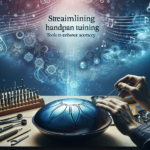In a world where the pace of life often feels relentless and our minds are constantly inundated with stimuli, finding a means to cultivate mindfulness and presence can be transformative. Deep mindfulness practices teach us to connect with the here and now, allowing us to appreciate the subtleties of the moment. One such practice that has garnered attention for its meditative qualities and its ability to create a flow state is handpan playing.
What is a Handpan?
The handpan is a relatively new musical instrument, first developed in the early 2000s. It consists of two metal half-shells glued together to form a hollow, resonant body. The top shell is indented with a series of tone fields, which are tuned to a specific scale. When struck with the hands, these fields produce a rich, ethereal sound that is both melodic and percussive.
Handpans are crafted with various scales and tunings, each providing a unique sonic landscape. The instrument’s simplicity and versatility make it accessible to beginners while offering depth and complexity for seasoned musicians.
The Connection Between Music and Mindfulness
Music has long been recognized for its therapeutic benefits, aiding in relaxation, reducing stress, and promoting well-being. The process of creating music engages multiple areas of the brain, fostering focus and presence. When played mindfully, the handpan can become a powerful tool for deep mindfulness.
Handpan playing involves a sensory experience where the player is completely absorbed in the sound and vibrations. This immersion helps to quiet the mental chatter and creates a direct connection with the present moment. The rhythm and melody guide the player into a state of flow, where time seems to stand still, and there is a profound sense of being “entirely here”.
Steps to Cultivate Mindfulness through Handpan Playing
1. Create a Calm Environment
Begin by setting up a peaceful space free from distractions. This could be a dedicated room, a corner of your home, or even an outdoor setting where you feel serene. The environment plays a crucial role in facilitating a mindful practice.
2. Ground Yourself
Before you start playing, take a few moments to ground yourself. You can do this by closing your eyes, taking deep breaths, and feeling the connection between your body and the ground. This helps to center your mind and prepare you for the practice ahead.
3. Embrace the Present
As you start playing, focus on the sounds produced by each strike of the handpan. Pay attention to the texture, tone, and resonance of the notes. Let these sounds anchor you to the present moment. If your mind starts to wander, gently guide your attention back to the music.
4. Stay Open and Non-Judgmental
Mindfulness involves observing without judgment. Approach your practice with curiosity and openness, allowing the music to unfold naturally. Avoid the temptation to critique your performance or compare yourself to others. Embrace any imperfections as part of the experience.
5. Incorporate Breathing
Synchronize your breath with your playing. Deep, slow breaths can enhance your connection to the instrument and deepen your sense of presence. As you exhale, feel the vibrations flow through you, amplifying your mindfulness.
The Psychological Benefits of Handpan Playing
Beyond the immediate experience of playing, regular handpan practice can have lasting psychological benefits. Some of these include:
- Stress Reduction: The calming sounds and repetitive motions of handpan playing can help reduce stress and anxiety.
- Improved Focus: By fostering a state of flow, handpan playing enhances concentration and cognitive clarity.
- Emotional Expression: Music provides a medium for expressing and processing emotions, leading to emotional resilience.
- Enhanced Creativity: The improvisational nature of handpan playing encourages creative expression and innovation.
Community and Connection Through Handpan
The handpan community is known for its inclusivity and supportive nature. Whether through online forums, social media groups, or local gatherings, players often share their experiences, insights, and music. This sense of community fosters a collective mindfulness, where individuals can connect over a shared passion and support each other’s journeys.
Participating in handpan circles or group meditations can also amplify the mindfulness experience. The collective energy and harmonized sounds created by multiple handpans can elevate the meditative state, deepening the sense of connection and presence.
Conclusion
Handpan playing offers a unique pathway to deep mindfulness, blending the therapeutic power of music with the practice of being present. By engaging with the handpan mindfully, individuals can cultivate a profound sense of inner peace, emotional resilience, and creative expression. This journey of connection—with oneself, the music, and the community—truly embodies the essence of being “entirely here”.
FAQs
Q: Do I need musical experience to play the handpan?
A: No, you do not need prior musical experience to begin playing the handpan. Its intuitive design and natural sound make it accessible to beginners. Many find that they can create beautiful music with minimal training.
Q: How can I find a handpan?
A: Handpans can be purchased through specialized makers and online retailers. Because they are often handmade, there can be a waiting list. It’s also possible to buy second-hand from other players. Ensure you purchase from a reputable source to guarantee quality.
Q: Can handpan playing help with anxiety?
A: Yes, many players report a reduction in anxiety due to the calming nature of the instrument and the mindfulness practice it encourages. The rhythmic playing can serve as a form of meditation, helping to soothe the mind.
Q: How often should I practice to see benefits?
A: Consistency is key. Even short, daily sessions can have significant benefits. Aim for at least 10-15 minutes a day to start. As you become more comfortable, you may naturally extend your practice time.
Q: Is it expensive to learn handpan?
A: While handpans themselves can be an investment, learning to play does not necessarily involve significant costs. There are many free resources available online, including tutorials and community advice. Some teachers offer reasonably priced lessons if you prefer guided learning.





